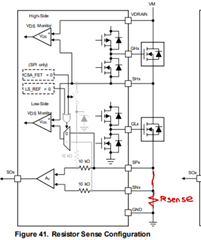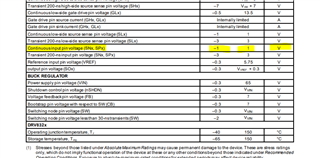E2E:
We currently use the DRV8320SRTV in our brushless motor controller with a single external current sense amplifier. For availability reasons, we're designing in the RV8323SRTA, but we do not intend on using its internal amplifiers. We are keeping our single external amplifier to mitigate risk.
The 8323's amplifiers pins replace the SLx pins that we use on the 8320, and it is a bit ambiguous in the datasheet, for our specific application, where we need to connect the SPx and SNx pins for each amplifier if we want to run the 8323 as if it were our original 8320. The relevant portion of the schematic is below:


As noted here: https://e2e.ti.com/support/motor-drivers-group/motor-drivers/f/motor-drivers-forum/676345/drv8323-current-sense-amplifier-question
They are told to connect the unused amplifier inputs to GND.
Where would be the best place to connect the SPx and SNx pins?
Thank you!








